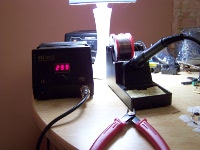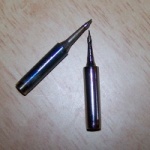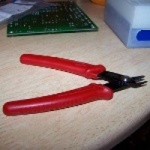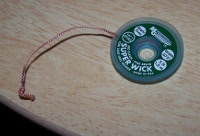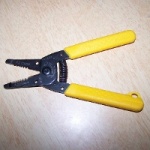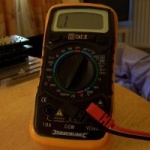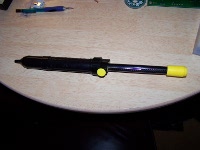DIYC Tools: Difference between revisions
| (6 intermediate revisions by 2 users not shown) | |||
| Line 8: | Line 8: | ||
The soldering iron needs to be a temperature controlled model. This is '''NOT''' a soldering '''GUN'''. Soldering Guns are made for large mechanical connections. Soldering Irons and stations are made for delicate electronics. The forums are full of advise on what model to get but the consensus is a [http://www.circuitspecialists.com/prod.itml/icOid/7508 Circuit Specialist Station 2A]. They even have a model for 240V mains at their European [http://www.circuitspecialists.eu/digital-display-soldering-station-csi-station2a-p-12.html site]. The reason is price vs. performance...minimum price and very good performance. Whatever station you buy, pick up extra tips as they are very cheap while you a buying the station but shipping gets bad when you only need one $3 tip. | The soldering iron needs to be a temperature controlled model. This is '''NOT''' a soldering '''GUN'''. Soldering Guns are made for large mechanical connections. Soldering Irons and stations are made for delicate electronics. The forums are full of advise on what model to get but the consensus is a [http://www.circuitspecialists.com/prod.itml/icOid/7508 Circuit Specialist Station 2A]. They even have a model for 240V mains at their European [http://www.circuitspecialists.eu/digital-display-soldering-station-csi-station2a-p-12.html site]. The reason is price vs. performance...minimum price and very good performance. Whatever station you buy, pick up extra tips as they are very cheap while you a buying the station but shipping gets bad when you only need one $3 tip. | ||
[[Image:CSI_2A.JPG | Station 2A]] [[Image:Tips.JPG |150px| Spare Tips]] | |||
===Snips=== | ===Snips=== | ||
| Line 13: | Line 15: | ||
These can be just a regular pair of side cutters. However, flush cut models work the best. Consider the comfort of the grips as your hands will get tired of making little snipping motions. | These can be just a regular pair of side cutters. However, flush cut models work the best. Consider the comfort of the grips as your hands will get tired of making little snipping motions. | ||
[[Image:FlushCut.jpg|Flush Cut Snips]] | [[Image:FlushCut.jpg|150px|Flush Cut Snips]] | ||
===Good Lighting=== | ===Good Lighting=== | ||
| Line 54: | Line 56: | ||
Well we do work with little wires! This can help out a lot and prevent problems. Any inexpensive pair of multi-gage strippers will work. Your teeth are not considered wire strippers. | Well we do work with little wires! This can help out a lot and prevent problems. Any inexpensive pair of multi-gage strippers will work. Your teeth are not considered wire strippers. | ||
[[Image:WireStrippers.JPG | Wire Strippers]] | [[Image:WireStrippers.JPG |150px| Wire Strippers]] | ||
===Digital Multi-Meter=== | ===Digital Multi-Meter=== | ||
| Line 62: | Line 64: | ||
Now, which one...well, they have wonderful very expensive models available..but you do not need it. Typical cost of $25 is normal for a decent model. Make sure that you look for one with a audible continuity test mode. This is normally shown on the dial as a small sound symbol. | Now, which one...well, they have wonderful very expensive models available..but you do not need it. Typical cost of $25 is normal for a decent model. Make sure that you look for one with a audible continuity test mode. This is normally shown on the dial as a small sound symbol. | ||
[[Image:DMM.JPG|Digital Multi-Meter]] | [https://learn.sparkfun.com/tutorials/how-to-use-a-multimeter How to use a Multimeter] | ||
[[Image:DMM.JPG|150px|Digital Multi-Meter]] | |||
===RJ45 Crimp Tool=== | ===RJ45 Crimp Tool=== | ||
| Line 109: | Line 113: | ||
===Etchant=== | ===Etchant=== | ||
===Bubbler=== | ===Bubbler=== | ||
[[Category:General Info]] | |||
[[Category:DIYC Index]] | |||
Latest revision as of 17:35, 22 August 2013
The Basics
Computer
Well you can't have computer controlled lighting without a Computer! The great thing about Vixen is that you do not need a supercomputer to run it. The forum has great suggestions on models that will work. Some members have found new Desktop PCs for under $300 that work fine. The only real requirement to watch out for is whether or not it has a parrallel or serial port. Different hardware uses different ports and their are new computers out there that do not have either of these ports. If you do not have these ports some adapters/expansion cards are available.
Soldering Station
The soldering iron needs to be a temperature controlled model. This is NOT a soldering GUN. Soldering Guns are made for large mechanical connections. Soldering Irons and stations are made for delicate electronics. The forums are full of advise on what model to get but the consensus is a Circuit Specialist Station 2A. They even have a model for 240V mains at their European site. The reason is price vs. performance...minimum price and very good performance. Whatever station you buy, pick up extra tips as they are very cheap while you a buying the station but shipping gets bad when you only need one $3 tip.
Snips
These can be just a regular pair of side cutters. However, flush cut models work the best. Consider the comfort of the grips as your hands will get tired of making little snipping motions.
Good Lighting
You really cannot say enough about how important good lighting is. A nice bright light can help solve many problems as well as prevent them. A light on a movable arm is really the best.
Good Workspace
This means a good uncluttered area with the above mentioned good lighting. It also means a comfortable chair. You will find yourself stooped over working with small parts. It is important that the height of your chair and table be appropriate for your comfort.
De-soldering Wick
This is also called de-soldering braid. This is a copper braid made for removing solder from a mistake. Yes, a mistake! We all have made them and we will not stop just because we do not like them. Just about any type will do but I have heard of some less than optimal performance from Radio Shack brands.
Small Screwdrivers
DIYC tasks are done with small parts...hence, you should have few small NON-MAGENTIC screwdrivers to help you out. The Non-magnetic part is simply that you do not want to get magnetized parts around IC chips.
Spare Parts
Okay, this is one of the most forotten items here. Things occasionally go wrong. If you do not have a couple of spares, you could find yourself in a bind. At a minimum, have extra Triacs, Pics, and Optos.
Solder Flux
This is a bit of a issue is not everyone uses it. However, sometimes you will have a component that just does not want to solder! This can solve all your worries. Solder Flux cleans the surface of the parts to be soldered. Most solder wire has flux inside it but having a small supply of this around will help.
Solder
Okay this is not a tool! But choices of solder will make your job much easier. Small diameter flux core wire is preferred. The 60/40 mix is normal although some use slightly different formulations like 63/37. Please do not get Acid Core solder. This does not play well with electronic components!
Some DIYC'ers ask about the use Lead Free solder. One word of caution, lead free solder is harder to use. For a novice, you might consider using normal leaded solder first, then trying the lead free version after you have gained some experience. Lead Free is harder to control, does not flow as well as leaded solder and requires a soldering iron with a much faster recovery time.
The Basics Plus
Wire Strippers
Well we do work with little wires! This can help out a lot and prevent problems. Any inexpensive pair of multi-gage strippers will work. Your teeth are not considered wire strippers.
Digital Multi-Meter
This is in the Plus section...but many think this is a basic requirement. If you have a problem and you want help from some of the more experienced members, this is a must have. We cannot help you without one.
Now, which one...well, they have wonderful very expensive models available..but you do not need it. Typical cost of $25 is normal for a decent model. Make sure that you look for one with a audible continuity test mode. This is normally shown on the dial as a small sound symbol.
RJ45 Crimp Tool
You can get by without one IF you buy all your CAT5 cables commercially. Very few DIYC members do this. Once again, this does not need to be $100+ models. A good one can be obtained for about $25 with good shopping.
Pic Programmer
This is an area of contention for some. However, once in a while a PIC will lose a program. What do you do? Well you can't fix it unless you have a buddy around the corner who does have one. We all try to help out and program chips for folks but in an emergency, it won't be enough. The DIYC concensus so far is the PICKitII from Microchip. There are other models cheaper that work, but this is the most versatile.
De-soldering Tool
A solder sucker or vacuum is the most popular and reasonably priced model. This is used to compliment solder wick and is not a replacement for it.
Magnifier
I do remember mentioning small parts somewhere before now. A magnifier with a light installed can be a great help
Chip Puller
“Okay, you have a problem? Well swap U11 chip for the U12 chip” How? Well that is where a chip puller helps. Fancy ones are not required. The tweezer type work quite well. Be careful to check the size range as they all have a “best used” range based on number of pins.
AS Equipment
I would be amiss if I did not mention this. Anti-Static Mats and and armbands are used by some some members. However, many of us to do not. The issue is you can get some static discharge damage if you do not take precautions. Grounding yourself to something metal before you touch IC parts does work.
"Helping Hands"
This is PCB holder that holds the board in a good position while you are sodlering. The best one is the models that hold the board along its edges. Avoid the types that use the small clips as the clips tend to scratch the PCB
